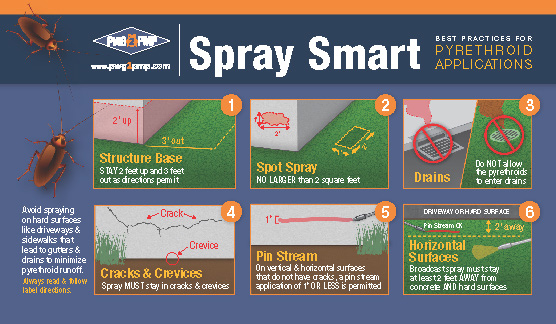As is the case with all pesticides, the United States Environmental Protection Agency (EPA) regulates pyrethroids in accordance with its mission to protect human health and the environment.
The EPA sets national standards and state regulators set state standards for all pesticides based on the best scientific information available to encourage the proper use of pesticides and to protect human health and the environment.
The EPA has its own extensive processes in place to continuously review existing registrations and incorporate the most current science. In conjunction with these efforts, the manufacturers of pyrethroids have conducted numerous studies over the past three decades to continuously assess the potential environmental impacts of pyrethroids. As noted below, adjustments in application requirements are made when necessary to ensure proper use. Some facts about pyrethroids and the environment include:
- Pyrethroids exhibit a unique combination of properties. The most important property is that they are hydrophobic (having little or no affinity for water). Thus they do not dissolve readily, and rapidly bind to soil and sediment in water bodies. For this reason, when pyrethroid residues have been found in the environment, they are usually found bound to sediment in areas where sediments collect in a water body. Pyrethroids are rarely detected or dissolved in the water itself.
- There have been no meaningful environmental incidents ascribed to pyrethroid residues in the environment in their 30+ years of use.
- Refined application procedures have been designed to reduce the likelihood of pyrethroid off-target movement. Current EPA labels reflect these changes in technology.
- Pyrethroids have been reviewed and approved for use by many government regulatory agencies around the world, including the US EPA and EU regulatory authorities. The use of pyrethroids has been approved in nearly 80 countries globally.
Habitat Research
Many studies have been conducted to assess the potential impact of pyrethroids on the environment, with most of the research focusing on the aquatic environment.
A number of important studies have been focused on Hyalella, small organisms that inhabit the bottoms of lakes and waterways. Hyalella in nature reside at the water column-sediment interface and prefer aquatic vegetation habitats, but can also be found in depositional and non-depositional areas. Because pyrethroids bind to soil particles, pyrethroids may be found in areas of water bodies where sediments are deposited. Depositional zones are infrequent and are not the preferred habitat of Hyalella. While studies show that some of these sediments are toxic to Hyalella reared in the laboratory, most native Hyalella (found in California) are far less sensitive. Thriving populations of Hyalella have been discovered in water bodies where pyrethroids were found.
Application & Runoff Research
Government environmental agencies and the PWG agree that a common goal is to keep pesticides on their intended target sites. The PWG has conducted a wide range of research to determine how pyrethroids enter urban creeks and waterways. The studies have found that applications to impervious surfaces such as driveways and sidewalks were largely responsible for creating runoff that eventually reached waterways. Consistent with EPA-approved directions for use, runoff from these applications is now mitigated by modified application methods.
Urban Waterway Studies
The PWG has conducted numerous studies on pyrethroids in California waterways. For example, the profile of pyrethroids in the American River near Sacramento, California was determined over time to provide a sound basis for evaluating the potential for exposure to sensitive aquatic organisms.

